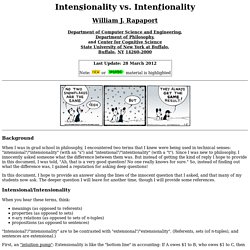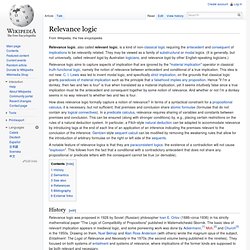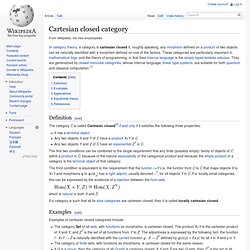

Intensionality vs. Intentionality. Department of Computer Science and Engineering, Department of Philosophy, and Center for Cognitive ScienceState University of New York at Buffalo, Buffalo, NY14260-2000 Background When I was in grad school in philosophy, I encountered two terms that I knew were being used in technical senses: "intensional"/"intensionality" (with an "s") and "intentional"/"intentionality" (with a "t").

Since I was new to philosophy, I innocently asked someone what the difference between them was. But instead of getting the kind of reply I hope to provide in this document, I was told, "Ah, that is a very good question! No one really knows for sure. " In this document, I hope to provide an answer along the lines of the innocent question that I asked, and that many of my students now ask. Intensional/Intensionality First, an "intuition pump": Extensionality is like the "bottom line" in accounting: If A owes $1 to B, who owes $1 to C, then We'll begin with two easy cases. Sequent calculus. In proof theory and mathematical logic, sequent calculus is a family of formal systems sharing a certain style of inference and certain formal properties.

The first sequent calculi, systems LK and LJ, were introduced by Gerhard Gentzen in 1934 as a tool for studying natural deduction in first-order logic (in classical and intuitionistic versions, respectively). Gentzen's so-called "Main Theorem" (Hauptsatz) about LK and LJ was the cut-elimination theorem, a result with far-reaching meta-theoretic consequences, including consistency. Gentzen further demonstrated the power and flexibility of this technique a few years later, applying a cut-elimination argument to give a (transfinite) proof of the consistency of Peano arithmetic, in surprising response to Gödel's incompleteness theorems. Introduction[edit] where. Cut-elimination theorem. The cut-elimination theorem (or Gentzen's Hauptsatz) is the central result establishing the significance of the sequent calculus.

Substructural logic. In logic, a substructural logic is a logic lacking one of the usual structural rules (e.g. of classical and intuitionistic logic), such as weakening, contraction, exchange or associativity.

Two of the more significant substructural logics are relevant logic and linear logic. In a sequent calculus, one writes each line of a proof as as the sequent notation for (A and B) implies C. Since conjunction is a commutative and associative operation, the formal setting-up of sequent theory normally includes structural rules for rewriting the sequent Γ accordingly - for example for deducing from There are further structural rules corresponding to the idempotent and monotonic properties of conjunction: from we can deduce Also from one can deduce, for any B, These are basic examples of structural rules. Premise composition[edit] There are numerous ways to compose premises (and in the multiple conclusion case, conclusions as well). Relevance logic. Relevance logic aims to capture aspects of implication that are ignored by the "material implication" operator in classical truth-functional logic, namely the notion of relevance between antecedent and conditional of a true implication.

This idea is not new: C. I. Linear logic. Connectives, duality, and polarity[edit] Syntax[edit] The language of classical linear logic (CLL) is defined inductively by the BNF notation Here and ⊥ range over logical atoms.

Braided monoidal category. C*-algebra. Intuitionistic logic. ("true" and "false" respectively) regardless of whether we have direct evidence for either case.

In contrast, propositional formulae in intuitionistic logic are not assigned any definite truth value at all and instead only considered "true" when we have direct evidence, hence proof. (We can also say, instead of the propositional formula being "true" due to direct evidence, that it is inhabited by a proof in the Curry-Howard sense.) Kripke semantics. Kripke semantics (also known as relational semantics or frame semantics, and often confused with possible world semantics) is a formal semantics for non-classical logic systems created in the late 1950s and early 1960s by Saul Kripke and André Joyal.

It was first made for modal logics, and later adapted to intuitionistic logic and other non-classical systems. The discovery of Kripke semantics was a breakthrough in the theory of non-classical logics, because the model theory of such logics was nonexistent before Kripke. Heyting algebra. It follows from the definition that 1 ≤ 0 → a, corresponding to the intuition that any proposition a is implied by a contradiction 0.

Although the negation operation ¬a is not part of the definition, it is definable as a → 0. The definition implies that a ∧ ¬a = 0, making the intuitive content of ¬a the proposition that to assume a would lead to a contradiction, from which any other proposition would then follow. Cartesian closed category. Definition[edit] The category C is called Cartesian closed[2] if and only if it satisfies the following three properties: The third condition is equivalent to the requirement that the functor –×Y (i.e. the functor from C to C that maps objects X to X×Y and morphisms φ to φ×idY) has a right adjoint, usually denoted –Y, for all objects Y in C.

For locally small categories, this can be expressed by the existence of a bijection between the hom-sets which is natural in both X and Z. If a category is such that all its slice categories are cartesian closed, then it is called locally cartesian closed. Classical logic. Classical logic identifies a class of formal logics that have been most intensively studied and most widely used. The class is sometimes called standard logic as well.[1][2] They are characterised by a number of properties:[3] While not entailed by the preceding conditions, contemporary discussions of classical logic normally only include propositional and first-order logics.[4][5] Boolean algebra (structure)